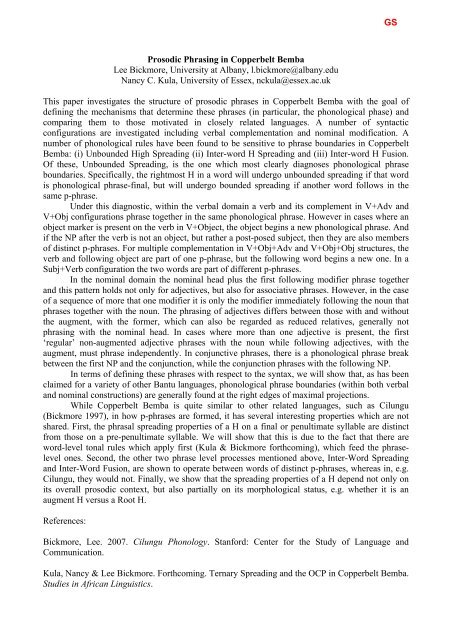here - 5th International Conference on Bantu Languages
here - 5th International Conference on Bantu Languages
here - 5th International Conference on Bantu Languages
You also want an ePaper? Increase the reach of your titles
YUMPU automatically turns print PDFs into web optimized ePapers that Google loves.
Prosodic Phrasing in Copperbelt Bemba<br />
Lee Bickmore, University at Albany, l.bickmore@albany.edu<br />
Nancy C. Kula, University of Essex, nckula@essex.ac.uk<br />
This paper investigates the structure of prosodic phrases in Copperbelt Bemba with the goal of<br />
defining the mechanisms that determine these phrases (in particular, the ph<strong>on</strong>ological phase) and<br />
comparing them to those motivated in closely related languages. A number of syntactic<br />
c<strong>on</strong>figurati<strong>on</strong>s are investigated including verbal complementati<strong>on</strong> and nominal modificati<strong>on</strong>. A<br />
number of ph<strong>on</strong>ological rules have been found to be sensitive to phrase boundaries in Copperbelt<br />
Bemba: (i) Unbounded High Spreading (ii) Inter-word H Spreading and (iii) Inter-word H Fusi<strong>on</strong>.<br />
Of these, Unbounded Spreading, is the <strong>on</strong>e which most clearly diagnoses ph<strong>on</strong>ological phrase<br />
boundaries. Specifically, the rightmost H in a word will undergo unbounded spreading if that word<br />
is ph<strong>on</strong>ological phrase-final, but will undergo bounded spreading if another word follows in the<br />
same p-phrase.<br />
Under this diagnostic, within the verbal domain a verb and its complement in V+Adv and<br />
V+Obj c<strong>on</strong>figurati<strong>on</strong>s phrase together in the same ph<strong>on</strong>ological phrase. However in cases w<str<strong>on</strong>g>here</str<strong>on</strong>g> an<br />
object marker is present <strong>on</strong> the verb in V+Object, the object begins a new ph<strong>on</strong>ological phrase. And<br />
if the NP after the verb is not an object, but rather a post-posed subject, then they are also members<br />
of distinct p-phrases. For multiple complementati<strong>on</strong> in V+Obj+Adv and V+Obj+Obj structures, the<br />
verb and following object are part of <strong>on</strong>e p-phrase, but the following word begins a new <strong>on</strong>e. In a<br />
Subj+Verb c<strong>on</strong>figurati<strong>on</strong> the two words are part of different p-phrases.<br />
In the nominal domain the nominal head plus the first following modifier phrase together<br />
and this pattern holds not <strong>on</strong>ly for adjectives, but also for associative phrases. However, in the case<br />
of a sequence of more that <strong>on</strong>e modifier it is <strong>on</strong>ly the modifier immediately following the noun that<br />
phrases together with the noun. The phrasing of adjectives differs between those with and without<br />
the augment, with the former, which can also be regarded as reduced relatives, generally not<br />
phrasing with the nominal head. In cases w<str<strong>on</strong>g>here</str<strong>on</strong>g> more than <strong>on</strong>e adjective is present, the first<br />
‘regular’ n<strong>on</strong>-augmented adjective phrases with the noun while following adjectives, with the<br />
augment, must phrase independently. In c<strong>on</strong>junctive phrases, t<str<strong>on</strong>g>here</str<strong>on</strong>g> is a ph<strong>on</strong>ological phrase break<br />
between the first NP and the c<strong>on</strong>juncti<strong>on</strong>, while the c<strong>on</strong>juncti<strong>on</strong> phrases with the following NP.<br />
In terms of defining these phrases with respect to the syntax, we will show that, as has been<br />
claimed for a variety of other <strong>Bantu</strong> languages, ph<strong>on</strong>ological phrase boundaries (within both verbal<br />
and nominal c<strong>on</strong>structi<strong>on</strong>s) are generally found at the right edges of maximal projecti<strong>on</strong>s.<br />
While Copperbelt Bemba is quite similar to other related languages, such as Cilungu<br />
(Bickmore 1997), in how p-phrases are formed, it has several interesting properties which are not<br />
shared. First, the phrasal spreading properties of a H <strong>on</strong> a final or penultimate syllable are distinct<br />
from those <strong>on</strong> a pre-penultimate syllable. We will show that this is due to the fact that t<str<strong>on</strong>g>here</str<strong>on</strong>g> are<br />
word-level t<strong>on</strong>al rules which apply first (Kula & Bickmore forthcoming), which feed the phraselevel<br />
<strong>on</strong>es. Sec<strong>on</strong>d, the other two phrase level processes menti<strong>on</strong>ed above, Inter-Word Spreading<br />
and Inter-Word Fusi<strong>on</strong>, are shown to operate between words of distinct p-phrases, w<str<strong>on</strong>g>here</str<strong>on</strong>g>as in, e.g.<br />
Cilungu, they would not. Finally, we show that the spreading properties of a H depend not <strong>on</strong>ly <strong>on</strong><br />
its overall prosodic c<strong>on</strong>text, but also partially <strong>on</strong> its morphological status, e.g. whether it is an<br />
augment H versus a Root H.<br />
References:<br />
Bickmore, Lee. 2007. Cilungu Ph<strong>on</strong>ology. Stanford: Center for the Study of Language and<br />
Communicati<strong>on</strong>.<br />
Kula, Nancy & Lee Bickmore. Forthcoming. Ternary Spreading and the OCP in Copperbelt Bemba.<br />
Studies in African Linguistics.<br />
GS


